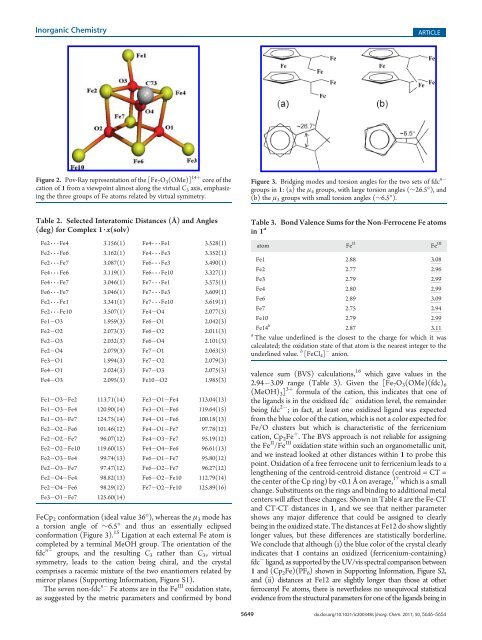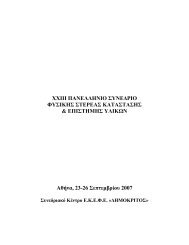Iron(III) Chemistry with Ferrocene-1,1-dicarboxylic Acid (fdcH2 ...
Iron(III) Chemistry with Ferrocene-1,1-dicarboxylic Acid (fdcH2 ...
Iron(III) Chemistry with Ferrocene-1,1-dicarboxylic Acid (fdcH2 ...
Create successful ePaper yourself
Turn your PDF publications into a flip-book with our unique Google optimized e-Paper software.
Inorganic <strong>Chemistry</strong><br />
ARTICLE<br />
Figure 2. Pov-Ray representation of the [Fe 7 O 3 (OMe)] 14þ core of the<br />
cation of 1 from a viewpoint almost along the virtual C 3 axis, emphasizing<br />
the three groups of Fe atoms related by virtual symmetry.<br />
Figure 3. Bridging modes and torsion angles for the two sets of fdc n<br />
groups in 1: (a) the μ 4 groups, <strong>with</strong> large torsion angles (∼26.5°), and<br />
(b) the μ 3 groups <strong>with</strong> small torsion angles (∼6.5°).<br />
Table 2. Selected Interatomic Distances (Å) and Angles<br />
(deg) for Complex 1 3 x(solv)<br />
Fe2 333 Fe4 3.156(1) Fe4 333 Fe1 3.528(1)<br />
Fe2 333 Fe6 3.162(1) Fe4 333 Fe3 3.352(1)<br />
Fe2 333 Fe7 3.087(1) Fe6 333 Fe3 3.490(1)<br />
Fe4 333 Fe6 3.119(1) Fe6 333 Fe10 3.327(1)<br />
Fe4 333 Fe7 3.046(1) Fe7 333 Fe1 3.575(1)<br />
Fe6 333 Fe7 3.046(1) Fe7 333 Fe3 3.609(1)<br />
Fe2 333 Fe1 3.341(1) Fe7 333 Fe10 3.619(1)<br />
Fe2 333 Fe10 3.507(1) Fe4 O4 2.077(3)<br />
Fe1 O3 1.959(3) Fe6 O1 2.042(3)<br />
Fe2 O2 2.073(3) Fe6 O2 2.011(3)<br />
Fe2 O3 2.032(3) Fe6 O4 2.101(3)<br />
Fe2 O4 2.079(3) Fe7 O1 2.063(3)<br />
Fe3 O1 1.994(3) Fe7 O2 2.079(3)<br />
Fe4 O1 2.024(3) Fe7 O3 2.075(3)<br />
Fe4 O3 2.095(3) Fe10 O2 1.985(3)<br />
Fe1 O3 Fe2 113.71(14) Fe3 O1 Fe4 113.04(13)<br />
Fe1 O3 Fe4 120.90(14) Fe3 O1 Fe6 119.64(15)<br />
Fe1 O3 Fe7 124.75(14) Fe4 O1 Fe6 100.18(13)<br />
Fe2 O2 Fe6 101.46(12) Fe4 O1 Fe7 97.78(12)<br />
Fe2 O2 Fe7 96.07(12) Fe4 O3 Fe7 95.19(12)<br />
Fe2 O2 Fe10 119.60(15) Fe4 O4 Fe6 96.61(13)<br />
Fe2 O3 Fe4 99.74(13) Fe6 O1 Fe7 95.80(12)<br />
Fe2 O3 Fe7 97.47(12) Fe6 O2 Fe7 96.27(12)<br />
Fe2 O4 Fe4 98.82(13) Fe6 O2 Fe10 112.79(14)<br />
Fe2 O4 Fe6 98.29(12) Fe7 O2 Fe10 125.89(16)<br />
Fe3 O1 Fe7 125.60(14)<br />
FeCp 2 conformation (ideal value 36°), whereas the μ 3 mode has<br />
a torsion angle of ∼6.5° and thus an essentially eclipsed<br />
conformation (Figure 3). 15 Ligation at each external Fe atom is<br />
completed by a terminal MeOH group. The orientation of the<br />
fdc n groups, and the resulting C 3 rather than C 3v virtual<br />
symmetry, leads to the cation being chiral, and the crystal<br />
comprises a racemic mixture of the two enantiomers related by<br />
mirror planes (Supporting Information, Figure S1).<br />
The seven non-fdc n Fe atoms are in the Fe <strong>III</strong> oxidation state,<br />
as suggested by the metric parameters and confirmed by bond<br />
Table 3. Bond Valence Sums for the Non-<strong>Ferrocene</strong> Fe atoms<br />
in 1 a<br />
atom Fe II Fe <strong>III</strong><br />
Fe1 2.88 3.08<br />
Fe2 2.77 2.96<br />
Fe3 2.79 2.99<br />
Fe4 2.80 2.99<br />
Fe6 2.89 3.09<br />
Fe7 2.75 2.94<br />
Fe10 2.79 2.99<br />
Fe14 b 2.87 3.11<br />
a The value underlined is the closest to the charge for which it was<br />
calculated; the oxidation state of that atom is the nearest integer to the<br />
underlined value. b [FeCl 4 ] anion.<br />
valence sum (BVS) calculations, 16 which gave values in the<br />
2.94 3.09 range (Table 3). Given the [Fe 7 O 3 (OMe)(fdc) 6<br />
(MeOH) 3 ] 3þ formula of the cation, this indicates that one of<br />
the ligands is in the oxidized fdc oxidation level, the remainder<br />
being fdc 2 ; in fact, at least one oxidized ligand was expected<br />
from the blue color of the cation, which is not a color expected for<br />
Fe/O clusters but which is characteristic of the ferricenium<br />
cation, Cp 2 Fe þ . The BVS approach is not reliable for assigning<br />
the Fe II /Fe <strong>III</strong> oxidation state <strong>with</strong>in such an organometallic unit,<br />
and we instead looked at other distances <strong>with</strong>in 1 to probe this<br />
point. Oxidation of a free ferrocene unit to ferricenium leads to a<br />
lengthening of the centroid-centroid distance (centroid = CT =<br />
the center of the Cp ring) by
















